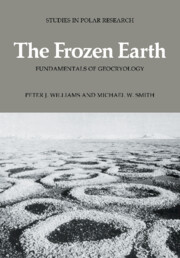Book contents
- Frontmatter
- Contents
- Symbols
- Preface
- Acknowledgements
- 1 PERIGLACIAL CONDITIONS
- 2 MORPHOLOGY OF PERMAFROST AND SEASONALLY FROZEN GROUND
- 3 CLIMATE AND FROZEN GROUND
- 4 THE GROUND THERMAL REGIME
- 5 THE FORMS OF THE GROUND SURFACE 1: SLOPES AND SUBSIDENCES
- 6 THE FORMS OF THE GROUND SURFACE 2: STRUCTURES AND MICROTOPOGRAPHY OF LEVEL GROUND
- 7 THERMODYNAMIC BEHAVIOUR OF FROZEN SOILS
- 8 HYDROLOGY OF FROZEN GROUND
- 9 THE MECHANICS OF FROZEN GROUND
- 10 GEOCRYOLOGY PAST AND FUTURE
- References
- Index
3 - CLIMATE AND FROZEN GROUND
Published online by Cambridge University Press: 24 October 2009
- Frontmatter
- Contents
- Symbols
- Preface
- Acknowledgements
- 1 PERIGLACIAL CONDITIONS
- 2 MORPHOLOGY OF PERMAFROST AND SEASONALLY FROZEN GROUND
- 3 CLIMATE AND FROZEN GROUND
- 4 THE GROUND THERMAL REGIME
- 5 THE FORMS OF THE GROUND SURFACE 1: SLOPES AND SUBSIDENCES
- 6 THE FORMS OF THE GROUND SURFACE 2: STRUCTURES AND MICROTOPOGRAPHY OF LEVEL GROUND
- 7 THERMODYNAMIC BEHAVIOUR OF FROZEN SOILS
- 8 HYDROLOGY OF FROZEN GROUND
- 9 THE MECHANICS OF FROZEN GROUND
- 10 GEOCRYOLOGY PAST AND FUTURE
- References
- Index
Summary
Introduction
The thermal regime in the upper layers of the earth is controlled by exchanges of heat and moisture between the atmosphere and the ground surface, together with the influence of ground thermal properties. The temperature at the ground surface undergoes fluctuations in response to changes in energy transfers, whilst the propagation of these fluctuations downwards depends on the thermal properties of the ground. The major surface temperature variation has a period of one year, corresponding to the annual cycle of solar radiation; there is also a diurnal variation corresponding to the daily cycle of radiation. Superimposed upon these periodic variations are other fluctuations with durations from seconds to years; these have a variety of causes, such as sporadic cloudiness, variations in the weather, and changes in climate.
The mechanisms of energy exchange at the earth's surface in cold regions are the same as those occurring elsewhere on the earth. Their significance springs from the fact that together they determine the surface temperature regime, and whether frozen ground will exist or not. The processes involved in the energy balance comprise the net exchange of radiation (represented by Q*) between the surface and the atmosphere, the transfer of sensible (QH) and latent heat (QLE) by the turbulent motion of the air, and the conduction of heat into the ground (QG).
- Type
- Chapter
- Information
- The Frozen EarthFundamentals of Geocryology, pp. 55 - 82Publisher: Cambridge University PressPrint publication year: 1989



